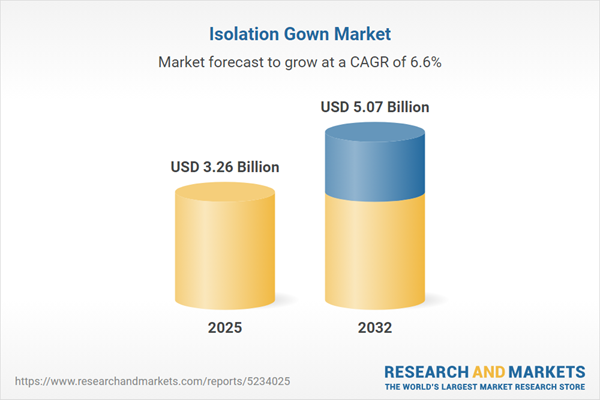Speak directly to the analyst to clarify any post sales queries you may have.
The isolation gown market is experiencing steady expansion, propelled by increased demands for safety, infection control, and regulatory compliance in healthcare and industrial environments. Innovation in materials and manufacturing, alongside evolving procurement strategies, is shaping a robust competitive landscape for senior decision-makers.
Market Snapshot: Isolation Gown Market Size and Growth
The isolation gown market grew from USD 3.04 billion in 2024 to USD 3.26 billion in 2025. The sector is projected to advance at a CAGR of 6.60%, with revenues anticipated to reach USD 5.07 billion by 2032. This upward momentum is driven by persistent healthcare demands, technological innovation, and evolving regulatory influences across global markets.
Scope & Segmentation: Key Segments and Regional Markets
This report delivers thorough analysis across a range of product categories, usage types, materials, applications, and global regions. Market segmentation includes:
- Product Type: Non-surgical isolation gowns, Surgical isolation gowns
- Usage Type: Disposable gowns, Reusable gowns
- Material: Cotton, Polyester, Polyethylene, Polypropylene
- Protection Level: Level 1, Level 2, Level 3, Level 4
- Distribution Channel: Offline, Online
- Application: Industrial uses, Medical uses (emergency response, IV procedures, surgical procedures)
- End-User: Ambulatory surgical centers, Clinics, Hospitals, Research & diagnostic laboratories
- Regions: Americas (North America: United States, Canada, Mexico; Latin America: Brazil, Argentina, Chile, Colombia, Peru), Europe (United Kingdom, Germany, France, Russia, Italy, Spain, Netherlands, Sweden, Poland, Switzerland), Middle East (UAE, Saudi Arabia, Qatar, Turkey, Israel), Africa (South Africa, Nigeria, Egypt, Kenya), Asia-Pacific (China, India, Japan, Australia, South Korea, Indonesia, Thailand, Malaysia, Singapore, Taiwan)
- Company Coverage: Leading and emerging manufacturers, including 3M Company, Ansell Limited, Medline Industries, Cardinal Health Inc., and Kimberly-Clark Corporation, among others
Key Takeaways for Senior Decision-Makers
- Material advancements, such as nanofiber membranes and antimicrobial coatings, are enhancing gown performance, enabling lighter, more protective, and environmentally conscious solutions.
- Robotics and AI-driven manufacturing are improving consistency and efficiency while supporting scalable, flexible production models to meet fluctuating healthcare demands.
- Manufacturers are strengthening supply chains using blockchain and IoT tracing for greater raw material transparency and regulatory compliance, reducing the risk of disruptions.
- Strategic partnerships between apparel technologists and chemical engineers are driving innovation, particularly in reusable gown technologies calibrated for both cost efficiency and sustainability goals.
- Sophisticated segmentation, such as protection level and material type, supports targeted product development and strategic procurement approaches for differing end-user requirements.
- Regional variations—ranging from stringent quality requirements in the Americas, regulatory harmonization in Europe, to high-volume manufacturing hubs in Asia-Pacific—underscore the need for locally responsive strategies to maximize market penetration.
Tariff Impact and Supply Chain Realignment
Recent U.S. tariff adjustments on nonwoven fabrics and specialty polymers have compelled buyers and manufacturers to reassess sourcing models. This has intensified the shift toward regional production footprints and expanded supplier networks in Southeast Asia and Latin America. Initiatives like nearshoring and value-engineering are supporting cost containment despite new trade complexities.
Methodology & Data Sources
This study utilizes a mixed-method research framework, combining in-depth secondary analysis of regulatory documents and market disclosures with primary interviews of key professionals across supply chains, procurement, and infection control. Quantitative validation is anchored in triangulation of production, import/export data, and pricing trends, ensuring the credibility and relevance of market intelligence.
Why This Report Matters
- Provides clear segmentation and actionable insights for product development, procurement, and investment planning in the isolation gown industry.
- Equips stakeholders with a comprehensive understanding of market risks, regulatory catalysts, and technology shifts enabling competitive advantage.
- Supports strategic decision-making with validated trend analysis, regional assessments, and context-specific recommendations for growth.
Conclusion
The isolation gown market is undergoing transformative shifts driven by regulatory evolution, supply chain innovation, and material advances. Senior leaders who adapt to these dynamics will maximize resilience, cost efficiency, and long-term value. This report offers the strategic foundation needed to navigate and capture opportunities in an evolving global landscape.
Additional Product Information:
- Purchase of this report includes 1 year online access with quarterly updates.
- This report can be updated on request. Please contact our Customer Experience team using the Ask a Question widget on our website.
Table of Contents
3. Executive Summary
4. Market Overview
7. Cumulative Impact of Artificial Intelligence 2025
Companies Mentioned
The companies profiled in this Isolation Gown market report include:- 3M Company
- Ansell Limited
- Alpha Pro Tech, Ltd
- Berner International GmbH
- Boston Scientific Corporation
- Cardinal Health Inc.
- DACH Schutzbekleidung GmbH & Co. KG
- DEREKDUCK INDUSTRIES CORP.
- Dispowear Sterite Company
- Dynarex Corporation
- Fannin Ltd by DCC plc
- Franz Mensch GmbH
- Kimberly-Clark Corporation
- Kingphar Medical Group
- Leboo Healthcare Products Limited
- Lohmann & Rauscher GmbH & Co. KG
- Medline Industries, LP
- Mölnlycke Health Care AB
- Narang Medical Ltd.
- Owens & Minor, Inc.
- Sengewald Klinikprodukte GmbH by Pregis Corporation
- Shanghai Medical Corporation
- Taromed Medical Inc.
- TIDI Products, LLC
- VWR International, LLC by Avantor, Inc.
- Winner Medical Co.Ltd
Table Information
| Report Attribute | Details |
|---|---|
| No. of Pages | 181 |
| Published | November 2025 |
| Forecast Period | 2025 - 2032 |
| Estimated Market Value ( USD | $ 3.26 Billion |
| Forecasted Market Value ( USD | $ 5.07 Billion |
| Compound Annual Growth Rate | 6.6% |
| Regions Covered | Global |
| No. of Companies Mentioned | 27 |









